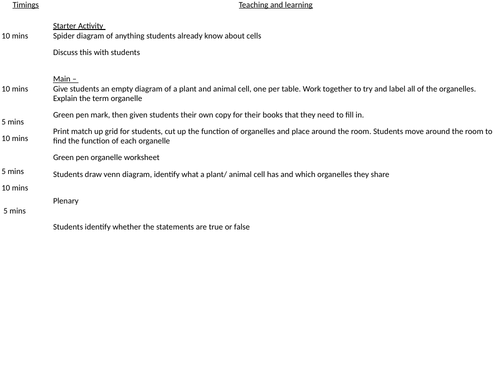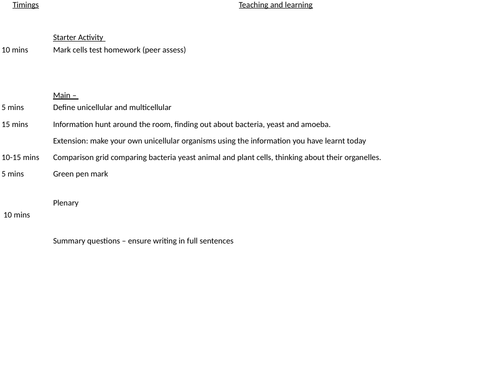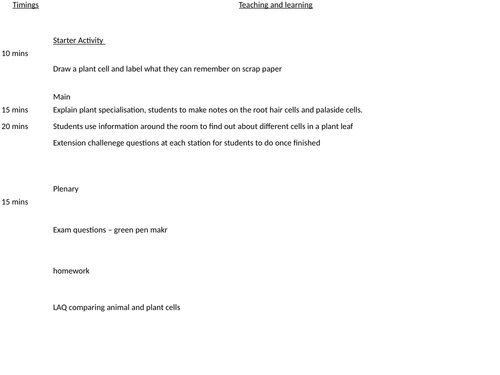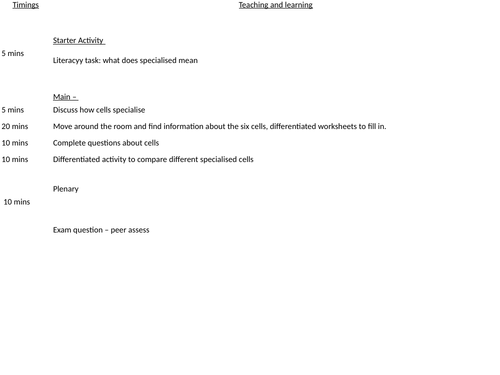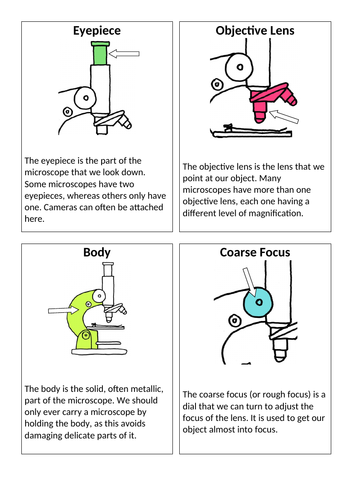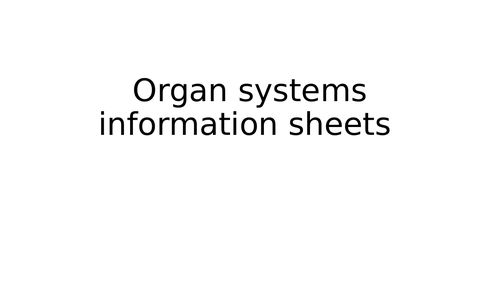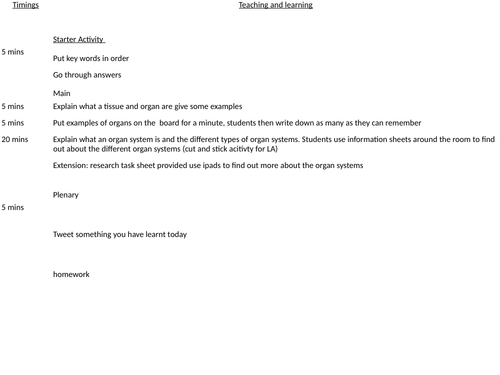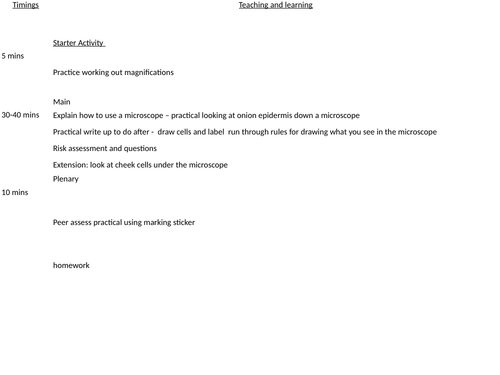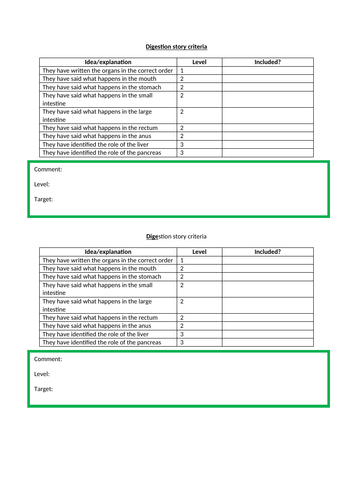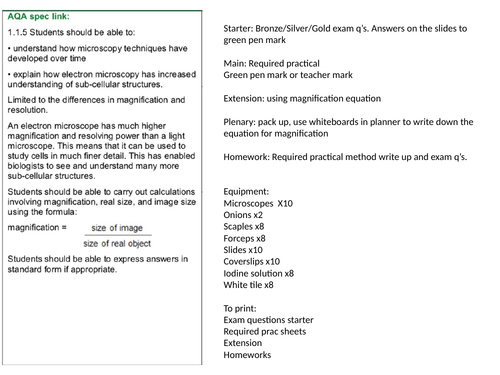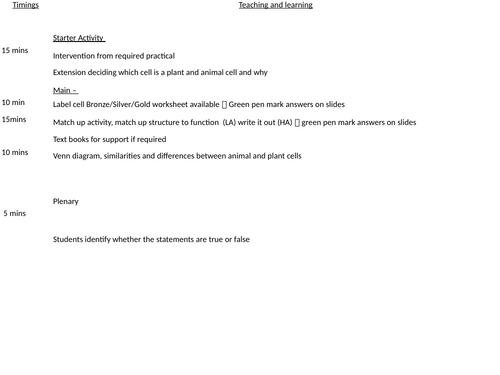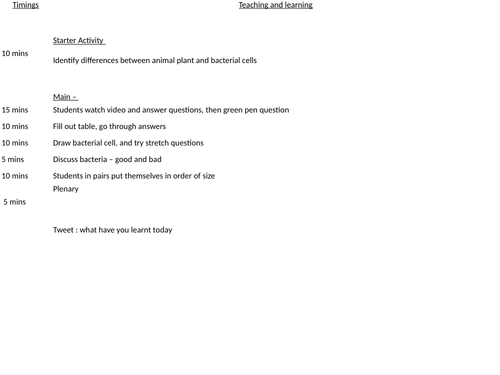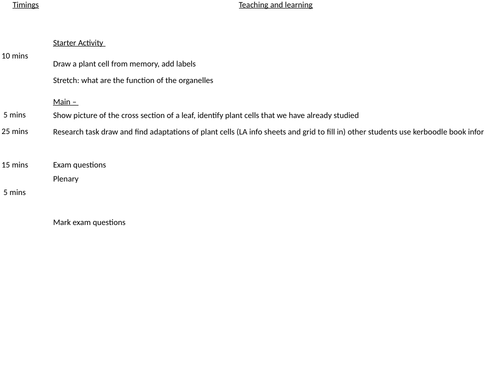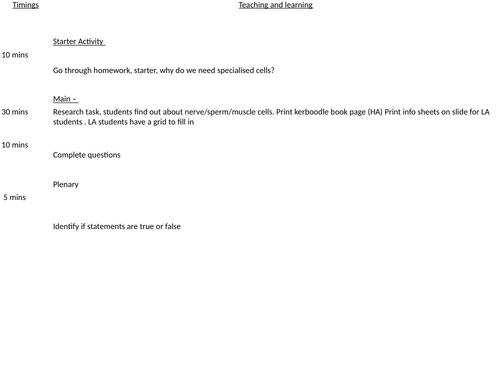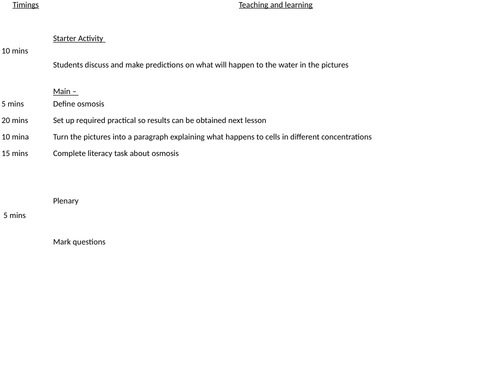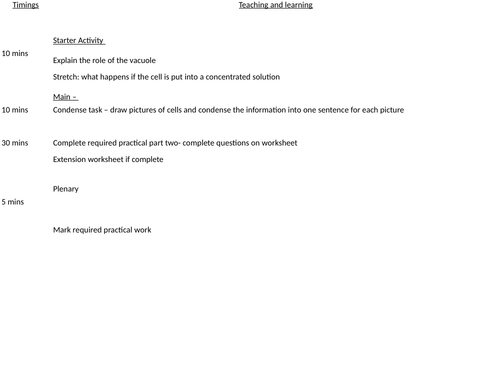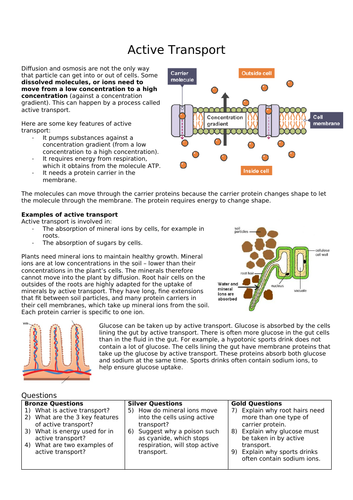
124Uploads
33k+Views
8k+Downloads
Biology

Plant and animal cells KS3
Aimed at a mixed ability year 7 class
10 mins
Spider diagram of anything students already know about cells
Discuss this with students
Give students an empty diagram of a plant and animal cell, one per table. Work together to try and label all of the organelles. Explain the term organelle
Green pen mark, then given students their own copy for their books that they need to fill in.
Print match up grid for students, cut up the function of organelles and place around the room. Students move around the room to find the function of each organelle
Green pen organelle worksheet
Students draw venn diagram, identify what a plant/ animal cell has and which organelles they share
Plenary
5 mins
Students identify whether the statements are true or false

Unicellular organisms KS3
Aimed at mixed ability year 7 class
Starter: how many cells make up the human body
Main: key definitions uni/multi cellular
task to move around the room and find out about different unicellular organisms
Comparison task to compare organelles in unicelllular organisms
Plenary: summary questions based on the lesson

Plant cells, tissues and organs KS3
Aimed at mixed ability year 7 class - some resources from other areas of TES
Starter: memory task, draw and label a plant cell with all they can remember
Main: draw and label root hair cell and palasaide cell, write the function and adaptations
use information around the room to fill in diagram of cells in a leaf and how they help photosynthesis
extension questions at each station
Plenary: exam questions

Animal cell specialisation KS3
Aimed at a mixed ability year 7 class
Starter: What does specialised mean?
Main: research task move around the room to find out about specialised animal cells
differentiated worksheet
answer questions about the cells
differentiated task to compare different cells
Plenary: Exam questions

Microscopes KS3
Aimed at a mixed ability year 7 class
5 mins
Differentiated questions to see what students know already about the microscope
Main
History of the microscope task – HA/LA version HA comprehension task about history, LA cut and stick to put in order
Show students parts on real microscope then cut and stick activity to label microscope parts – HA/LA version available as well as support sheets - go through answers
Extension: magnification calculations
Plenary
5 mins
Tweet something you have learnt today

Cells, tissues and organs KS3
Aimed at mixed ability year 7 class, some resources from other areas of tes
Starter: Put key words in size order and discuss
Main: discuss what cells tissues, organs are and examples
Organ systems worksheet to fill in using information around the room
LA version of cut and stick match up the organ, system and function
Extension: research extension questions about the organ systems (sheet provided)
Plenary: tweet something you have learnt today

Microscopes practical KS3
Aimed at mixed ability year 7 class
Starter: work out magnification
Main: Complete practical looking at onion epidermis and cheek cells
practical sheet to fill in
Plenary: Peer assess their practical work

The digestive system KS3
Aimed at mixed ability year 7 class
Starter: label the digestive system, green pen mark
Main: Move around the room and find information about the key organs of the digestive system
HA/MA/LA sheets to fill in
Write a food story of food moving through the digestive system
Plenary: peer assess food story, marking sticker included

Microscopes required practical
Aimed at a mixed ability year 9 class
Starter: Differentiated exam questions answers on the powerpoint to mark
Main: Required practical, worksheet to complete alongside. Answers on the powerpoint to self assess after
Extension: magnification exam questions to practice , answers on the powerpoint
Plenary: Pack up, write equation from memory
Homework sheet: Exam questions on magnification and method to write for the practical

B1.2 Animal and plant cells
Aimed at a mixed ability year 9 class
Starter: identify which cell is a plant cell and which is an animal cell and explain why
Main: Label plant and animal cells differentiated worksheets (bronze silver gold)
Match up strucutre and function of organelles
venn diagram similarities and differences between plant and animal cells
Plenary: true/false questions

B1.3 Eukaryotic and prokaryotic cells
Aimed at a mixed ability year 9 class
Starter: identify differences between plant/animal/bacterial cells from images given
Main: Watch video, answer questions, green pen (answers provided on ppt)
Fill out comparison table and draw own bacterial cell
stretch questions to reach highest levels
Discussion are all bacteria bad? images to support
6 mark question to compare cells
Plenary: order of magnitude, in pairs select an image then put themselves in order

B1.5 specialisation in plant cells
Aimed at a mixed ability year 9 class
Starter: recap draw and label plant cell. Stretch, describe the role of each organelle
Main: Discuss where the palaside cells are found, discuss why they are adapted for their function being here
research task: HA/LA versions find out about root hair cells, xylem, phloem
Exam questions
Plenary: mark exam questions

B1.4 Specialised animal cells
Aimed at a mixed ability year 9 class
Starter: why do animals have specialised cells, try and identify cells in the pictures
Main: Research task - using kerboodle books or any other resource, research criteria to meet for each cell.
Lower ability information sheets, and grid to fill in for LA students
Extension: answer questions
Plenary: identify if statements are true/ false

B1.6 Diffusion
Aimed at a mixed ability year 9 class
Starter: how do sharks find their prey easily
define diffusion
Main:: three practicals
affect of temperature
affect of concentration
affect of surface area
accompanying work sheet to fill in whilst completing practical
THen complete differentiated diffusion literacy task
Plenary: tweet what they have learnt today

B1.7 Osmosis
Aimed at a mixed ability year 9 class
Starter: Discuss and make a prediction about where the water willl move
bring it together with a definitoin of osmosis
Main: Set up practical so results can be looked at next lesson - method on slide
go through what happens to cells in different concentrations
differentiated literacy task
Plenary: mark questions

B1.8 Osmosis in plants
Aimed at a mixed ability year 9 class
Starter: what is the role of a vacuole
stretch: what happens to a plant cell if placed in concentrated sugar solution
Main: Complete required practical, record results, compelte worksheet
extension exam question if do complete
Plenary: mark required practical

Osmosis required practical
Two lessons split for the required practical, differentiated sheets available and practical worksheet

B1.9 active transport
Aimed at a mixed ability year 9 class
Starter: what would happen to the particles thinking about diffusions
Main: introduce active transport, define active transport. show where it works in plants and animal cells
complete differentiated literacy activity
Extension task
Plenary: mark work, tweet one thing they have learnt today

B1.10 exchange materials
Aimed at a mixed ability year 9 class
Starter: reflect on previous diffusion practical
Main: explain surface area:vol, do practic equestions and mark
do research task to explain how surfaces are specialised
extension: checkpoint follow ups from kerboodle
Plenary" tweet what theyve learnt

